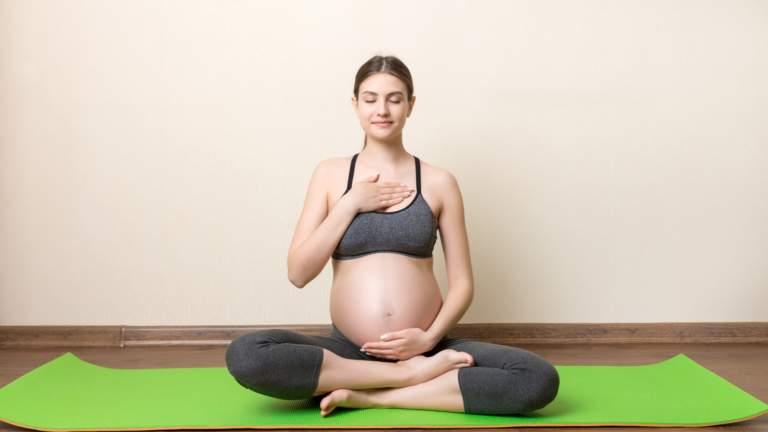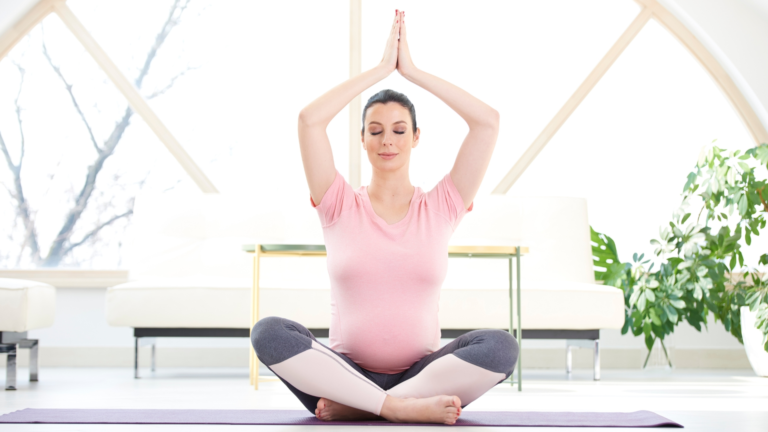How Can Pregnancy Yoga Help With Labor And Delivery?
Pregnancy is a beautiful journey filled with joy, anticipation, and growth, both physically and emotionally. Alongside the excitement, expectant mothers often experience a myriad of changes in their bodies and minds. One practice that has gained popularity in recent years for its potential benefits during pregnancy is yoga. Specifically, pregnancy yoga, also known as prenatal yoga, offers a gentle and effective way for mothers-to-be to stay fit, ease discomfort, and prepare mentally and physically for labor and delivery. Almost 30% of expectant moms are unaware of pregnancy yoga. In this blog, we’ll delve into the myriad ways in which pregnancy yoga can support women during this transformative time.
Exploring Pregnancy Yoga
Pregnancy yoga is specially made for expecting moms, combining gentle stretches, breathing exercises, and relaxation techniques like meditation. It’s all about keeping moms physically strong and emotionally balanced during pregnancy. Unlike regular yoga, it focuses on poses that are safe for both mom and baby. Pregnancy yoga creates a cozy environment for moms-to-be to connect with their bodies, find peace, and help their babies grow healthy and happy. It’s like a personalized journey for each mom, making sure they feel supported and cared for as they prepare to welcome their little one.

How Pregnancy Yoga Can Enhance Labor and Delivery
- Physical Preparation: Pregnancy yoga is vital for moms-to-be as it readies them physically for childbirth. By doing gentle stretches and exercises, pregnant women can strengthen the muscles required during labor. Online Pregnancy yoga classes enhance flexibility and endurance, making the birthing process smoother. It’s like training the body for the big event, ensuring expectant mothers feel more capable and confident when the time comes to deliver their baby.
- Pain Management Strategies: In pregnancy yoga, moms-to-be discover helpful breathing methods and relaxation exercises to ease labor pains. Deep breathing and mindfulness practiced during yoga sessions help reduce stress and anxiety, creating a calmer birthing environment. By mastering these techniques, expectant mothers can navigate labor with less discomfort, promoting a more positive and empowering birth experience for both themselves and their babies. You can also read our blog about “ Yoga Poses For Normal Delivery ” for more details about pregnancy yoga.
- Pelvic Floor Strengthening: Pregnancy yoga incorporates exercises targeting pelvic floor muscles. These muscles bear the weight of the growing baby and are crucial during childbirth. Strengthening them aids in preventing postpartum urinary incontinence and maintaining pelvic health. It is a workout for muscles to ensure they’re strong and supportive during pregnancy and beyond, contributing to overall well-being for both mom and baby.
- Optimal Fetal Positioning: Specific yoga postures facilitate the baby’s optimal positioning for birth, particularly head-down. These poses open the pelvis and promote alignment, potentially minimizing delivery complications like posterior positioning or breech presentation. Engaging in such movements empowers expectant mothers to actively participate in their birthing experience, enhancing the likelihood of a smoother delivery process and a healthier outcome for both mother and baby.
- Stress Reduction Techniques: Pregnancy is frequently accompanied by heightened stress and anxiety. Research indicates that pregnant women who practice yoga experience reduced levels of stress, anxiety, depression, and tiredness. Pregnancy yoga offers a sanctuary for women to unwind, fostering relaxation and deeper connection with their bodies and babies. Through mindfulness and meditation, expectant mothers cultivate inner peace, vital for navigating the challenges of labor and delivery. Such practice provides a safe haven for pregnant individuals to alleviate tension, promoting overall well-being during this transformative journey.
- Community Support: Participating in pregnancy yoga classes enables women to bond with other expectant mothers, sharing experiences and worries. A supportive community offers emotional sustenance throughout pregnancy and beyond, cultivating camaraderie and solidarity. By sharing in each other’s journey, participants find comfort and reassurance, creating lasting connections and friendships that enrich their prenatal experience and beyond.

- Bonding with Baby: Pregnancy yoga offers expectant mothers a chance to strengthen their connection with their unborn child. Gentle movements, visualization, and meditation techniques foster a deep bond, promoting feelings of love, acceptance, and unity. The enhanced connection positively impacts the birthing process, instilling a sense of calm and confidence in both mother and baby, creating a nurturing environment for their journey together.
- Postpartum Recovery: Pregnancy yoga not only supports childbirth but also aids in postpartum recovery. Techniques acquired during prenatal yoga, like breathing exercises and gentle stretching, facilitate healing, easing tension, and rebuilding strength and flexibility after childbirth. These practices assist new mothers in adapting to the physical and emotional changes of the postpartum period, promoting overall well-being as they navigate motherhood.
Breathing Techniques and Their Role in Labor
Breathing is a fundamental aspect of pregnancy yoga, and its importance extends to labor and delivery. Different breathing techniques can be employed at various stages of labor to manage pain, conserve energy, and facilitate relaxation.
Ujjayi Breath (Victorious Breath): This technique involves breathing deeply through the nose, filling the lungs, and exhaling slowly. It helps calm the mind, maintain focus, and increase the mother’s and baby’s oxygen supply.
Deep Belly Breathing: Deep belly breathing encourages full diaphragmatic breathing, which can help manage contractions and promote relaxation. It involves inhaling deeply into the abdomen, allowing it to expand, and exhaling fully.
Counting Breath: Counting breaths involves inhaling to a count of four and exhaling to a count of six. This technique can be particularly useful to maintain a steady rhythm and stay relaxed during early labor.
Sighing Breath: Sighing breath involves taking a deep breath in and then exhaling audibly, releasing tension with each breath. It can help relieve stress and anxiety during labor.
Practical Tips for Engaging in Pregnancy Yoga
- Consult with Healthcare Provider: Before initiating any exercise regimen during pregnancy, consulting a healthcare provider is crucial to ensure safety for both mother and baby. Tailored recommendations, accounting for medical history and individual requirements, are vital for a secure and beneficial practice. Ensuring that the chosen activities support maternal health and fetal development without posing any risks is crucial.

- Select a Qualified Instructor: Select online yoga classes or instructor with extensive experience and certification in prenatal yoga. Their expertise ensures tailored guidance and instruction, addressing the specific requirements of expectant mothers to maximize safety and effectiveness throughout the practice.
- Listen to Your Body: Be attentive to your body’s cues during pregnancy yoga. Modify or skip poses as required to prevent strain and prioritize comfort. Such an approach minimizes the risk of injury, ensuring a safe and enjoyable practice tailored to your changing needs throughout pregnancy.
- Stay Hydrated and Nourished: During pregnancy, it’s important to drink 8 to 12 cups (64 to 96 ounces) of water daily. Stay hydrated by drinking ample water before, during, and after pregnancy yoga sessions. A nutrient-rich diet supports energy levels and overall well-being throughout pregnancy. Ensuring hydration and proper nutrition optimizes your yoga practice, enhancing its benefits for both you and your baby’s health.
- Incorporate Mindfulness and Relaxation: Embrace the relaxation and meditation aspects of pregnancy yoga to nurture inner peace and tranquility. Integrate deep breathing exercises into your daily regimen to effectively cope with stress and induce a state of relaxation. These practices foster emotional well-being, enhancing your overall experience during pregnancy and beyond.
Conclusion
Pregnancy yoga is a powerful tool for expectant mothers seeking to enhance their pregnancy experience and prepare for the journey of childbirth. By incorporating gentle stretching, breathing techniques, meditation, and relaxation exercises into their prenatal routine, women can reap a myriad of benefits that extend far beyond the physical realm.
From enhanced relaxation and pain management to improved strength and endurance, pregnancy yoga equips expectant mothers with the tools they need to navigate labor and delivery with greater ease and confidence. By promoting optimal fetal positioning, emotional empowerment, and postpartum recovery, yoga supports women at every stage of the childbirth process, helping them embrace the transformative journey of motherhood with grace and resilience.
As you embark on your pregnancy journey, consider incorporating pregnancy yoga into your routine to experience the profound benefits it has to offer. Whether you’re a seasoned yogi or new to the practice, prenatal yoga provides a safe and nurturing space to connect with your body, your baby, and your inner strength as you prepare to welcome new life into the world. Embrace the journey, trust in your body’s wisdom, and let the transformative power of pregnancy yoga guide you through the miraculous experience of childbirth.



